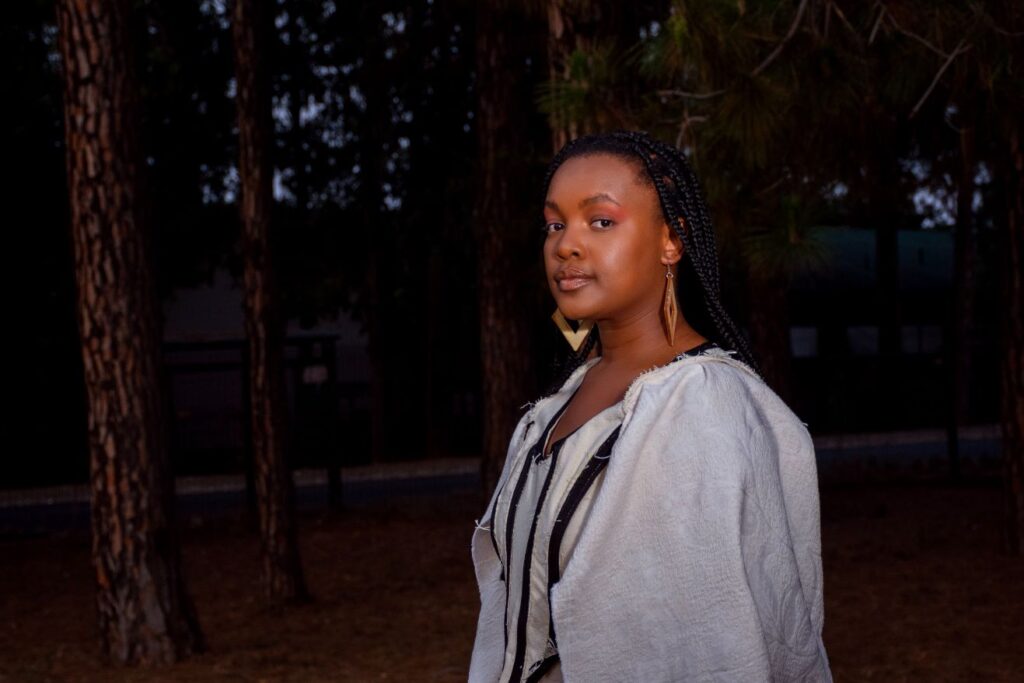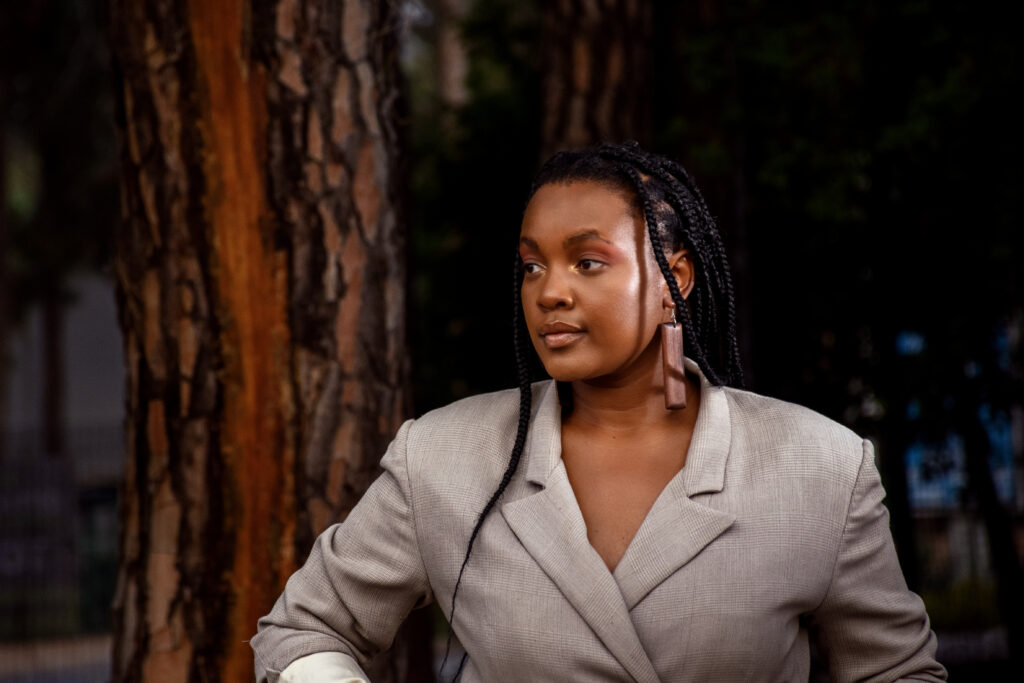Building a Sustainable South African Fashion Brand for Generations: Meet Gontse Lefa Rafedile
With its history of environmental damage, cultural appropriation and greenwashing, the fashion industry can be controversial. Fortunately, artists like Gontse Rafedile maintain their creativity in an ethical manner. Gontse talks to In Mzansi about her sustainable South African fashion brand, Lefalaka, and how its sustainability is a beacon of wearable quality that can endure for generations.

Gontse’s voice echoes through the room over the speaker. Her voice is bold, but there is a warmth that makes you feel her friendly presence, even if it is virtual. We chat before getting into the core of her freelance career in not just fashion but design as a whole. Gontse has always been an artist at heart and, since she started her freelance career in 2015, it has only taken flight.
“Well, when I was growing up, I would always get into trouble”, she begins. As a child, Gontse would drape tablecloths, curtains and bed linen, imagining a runway with an enthusiastic crowd on each side of the aisle cheering on her DIY designs. Her fashion show fantasy would always come to a dramatic stop as she would get a spanking from her parents. She reminisces about it as funny moments: “I just dressed up, like a princess; at that time, it was all about the fabric.” Her growing curiosity in fashion presented as an interest in art. During primary school, her creative spirit was constantly dabbling in anything that had to do with arts and crafts.


One day, her primary school hosted a special guest speaker. He was a musician and swept everyone away with his impressive piano skills. The mesmerising piano player told the group of learners that he was from a high school called the NSA and encouraged everyone to apply there. From then, Gontse knew she wanted to go to that mysterious ‘NSA’ that held talented creatives like the piano player. The NSA turned out to be the National School of the Arts, a prestigious art school that has produced the likes of Charlize Theron, Langa Mavuso, and Zoë Modiga.
“Everyone was raving about the school at the time,” says Gontse with a sparkle in her eye. Gontse was accepted the second time around at the NSA as an art major, something which brought tears of joy to her eyes when she found out. The fast-paced art subject in the NSA exposed her to drawing, jewellery making, painting, photography, pottery and videography. “In Grade 10, I gravitated towards 3D which involved fashion”. This allowed her to explore the wonderful world of fashion design.

Gontse began making dashikis during her gap year. ‘Dashiki‘ is a Yoruba word which refers to the loose-fitting pullovers that originated in West Africa as a functional work tunic for men which is comfortable enough to wear in the heat. Today, most cultures in different parts of the world have embraced dashikis as part of casual wear. It is now an African fashion statement rather than practical work attire. Gontse’s dashikis were much in demand leading to the expansion of her skills to produce bags and other custom orders.
But she soon encountered a problem: “I got to realise that people do not respect the craft and people did not pay on time. They took advantage because I was young.” This challenge motivated her to pursue tertiary education and she enrolled at the University of Johannesburg’s Diploma in Fashion Production. The programme explores all aspects of the fashion industry by teaching the fashion system from production through to consumption in order to meet market demands. Even though she was studying, she continued to freelance as there was a demand for her designs. Business was booming: “I realised that I can literally sit [and produce clothing] with no marketing, only word of mouth. So, I became serious because, where I was, people needed a good seamstress.”



I ask her about her inspiration before admitting that it was a clichéd question. She teases me, “That is a very corny question”. After laughing, she responds that she gains inspiration from the past. She is intrigued at how people live, how their living inspires everything they do and how they dress.
“Also, there are problems in the fashion industry where clothes don’t fit,” Gontse says. She stresses, in that stern, concerned voice, that most retail stores and luxury brands use a South African standard size chart that originates from a European size chart. As a result, the clothes aren’t as true to size as the South African demographic includes diverse body types. This is something she closely observes in order to analyse how she can address the issue. “How can I help other people? How can I help my people? And most of all, how can we help ourselves through clothing? A piece of clothing should help the customer, but at the same time, the customer should feel like they’ve helped themselves and like they’ve also helped the environment.”
With Lefalaka, Gontse has plans to answer all those questions. Gontse’s brand emphasises sustainability which is very important right now. Sustainable fashion is an all-inclusive term describing products, processes and activities which aim to achieve a carbon-neutral fashion industry, built on equality, social justice, animal welfare, and ecological integrity. As much as the youth embraces thrifting and sustainable brands, fast fashion continues to create waste with its synthetic material.
Pre-1994, South Africa had its fabric mills, but they closed down after the market flooded with cheap imported clothing. When trade restrictions relaxed after Apartheid, local manufacturers began to source material from more affordable destinations. The decline in demand for local fabric, combined with the higher wages post-Apartheid South African workers had to be paid, meant that the cost of locally-made products increased. Now, South Africa is importing a lot of synthetic clothing that is hurting the environment. “Hence, I asked myself, what can Lefalaka do in terms of being sustainable?” Gontse explains, “And I figured out that when we produce locally, we can create employment so we’re able to boost our economy.”
Gontse is the epitome of a passionate and diligent businesswoman who not only wants to create but acknowledges the history and technical aspects of fashion as she builds her sustainable South African brand. “Right now, I’m learning how to weave. Weaving is a technique to create fabric from scratch. So, I’m now exploring that to see if I can make my own fabric.”
In 2021 Gontse’s designs were featured on a runway just like she dreamed of as a little girl. Three of Gontse’s creations graced the SA Menswear Week runway, which was the first digital fashion week in Africa. However, this time, she had models to wear her designs, and the material was definitely not her parents’ tablecloths.
Gontse credits her inheritance with her success. Lefa is Gontse’s second name given to her by her mother. It means ‘inheritance’ in Tswana. “After I found out how I got the name and what it means, I realised that this skill I have is literally an inheritance,” she says. Her maternal grandmother used to work in a factory producing sewing machinery, while also being able to sew herself. “Just to make ends meet, she would knit jerseys so my mom and her siblings could wear them at school”.
Interestingly, Gontse’s paternal grandmother was also into arts and crafts. “There was a point when I found fashion patterns in her bedroom, and she also had a sewing machine.” Today, her paternal grandmother’s vintage sewing machine is a sentimental piece in her home. It serves as a constant reminder of the talents which were subtly passed down to her. “So then I realised that this is a true inheritance.” This is why her brand name is Lefalaka which means ‘my inheritance’. The moniker also alludes to the customer’s inheritance, showing that, as a sustainable South African fashion brand, Lefalaka’s quality is good enough for the customer to pass it down someday, contributing to the sustainability of fashion.

Last year, Gontse was one of 1 000 African women selected for a scholarship for the Ingressive for Good Photoshop Course. It was an experience for her to take her design skills to another level where she experimented with design software. “I learned that Photoshop is not that hard,” she laughs. Even though she boasts several achievements working with various brands, she is currently rebranding. Out of all of her successes, she believes her greatest milestone is learning to be self-sufficient. Gontse is a frequent user of public transport and a serial pedestrian. Public transport in South Africa is often inconsistent and unreliable but Gontse is grateful to have access to it so she can get business done. “Being an entrepreneur requires you to look at what you have, use what you have and make it work for you”.
Gontse Lefa Radefile’s artistic abilities are a precious inheritance. Her knowledge about the past and the fashion industry have assisted her in building the sustainable South African brand that is Lefalaka, and her drive and focus serve as an inspiration for us young people. Gontse’s endeavours will continue and we can’t wait to see Lefalaka fashions strutting down more runaways!


